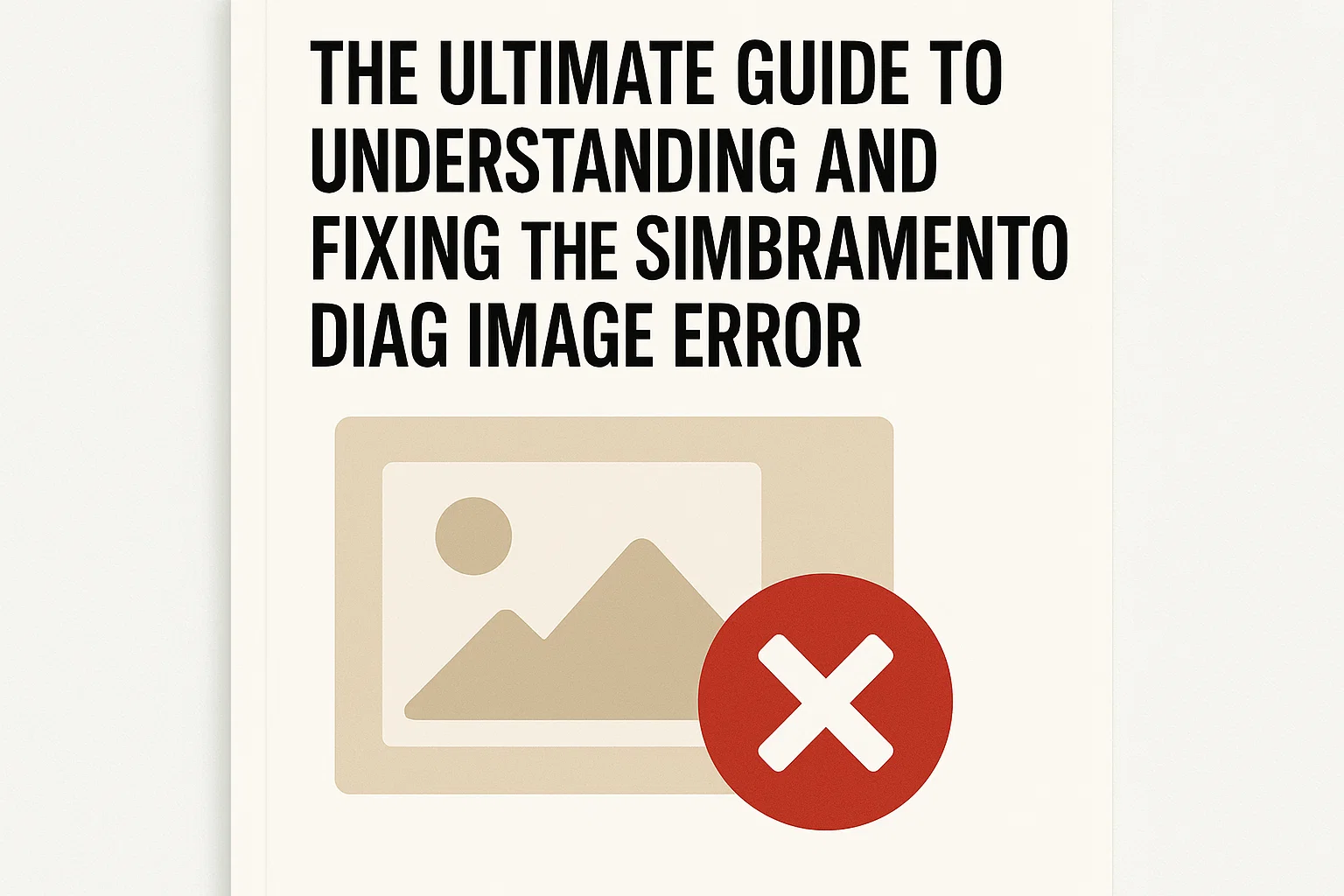The Ultimate Guide to Understanding and Fixing the Simbramento Diag Image Error
You’re in the zone. Your code is compiling, your design is coming together, and you’re making serious progress on your project. Then, out of nowhere, it happens. A cryptic error message flashes on your screen, stopping you dead in your tracks: simbramento diag image. Your momentum evaporates, replaced by a wave of confusion and frustration. What does it even mean? Is it a problem with your software? Your hardware? Did you break something?
If this scenario sounds familiar, you are far from alone. The simbramento diag image error is a notorious and often perplexing issue that primarily plagues users within specific software ecosystems, particularly those involving complex computational tasks, 3D rendering, CAD design, and advanced graphics processing. It’s one of those errors that seems to offer no clear path to a solution, sending users down endless rabbit holes of forum threads and makeshift fixes.
This article is your definitive guide to demystifying this error. We will dissect its origins, explore its common causes in plain language, and provide you with a comprehensive, step-by-step action plan to resolve it. More importantly, we will equip you with the knowledge to prevent it from happening again, ensuring a smoother, more stable computing experience. Consider this your one-stop resource for turning a moment of panic into a manageable troubleshooting task.
What Exactly is a Simbramento Diag Image Error?
Let’s start by breaking down the term itself, as its unusual name is a significant source of the confusion. “Simbramento” is not a standard English word and is believed to be a code name or an internal project designation that somehow leaked into public error messages. It’s often associated with software components related to simulation, rendering, or memory management. “Diag” is a common abbreviation for “diagnostic,” and “image” points towards a graphical component, a process snapshot, or a memory dump.
Therefore, a simbramento diag image error typically refers to a critical failure where a program attempts to create a diagnostic report or snapshot (an “image”) of its state at the moment of a crash, but the process itself fails catastrophically. It’s a meta-error—an error in the error-handling process. This failure often manifests within the software you are using, but its roots can extend deep into your system’s core, involving drivers, hardware, and operating system files.
Understanding this error requires a shift in perspective. You’re not just looking for what caused the initial software glitch; you’re also investigating why the system’s safety net (the diagnostic process) itself tore apart. This dual nature makes it a complex puzzle. It often appears in relation to low-level system operations, especially when software attempts to access protected memory space or when a crucial driver fails to respond correctly. The error is a symptom of a deep instability, not the cause itself.
Common Culprits: What Causes This Error to Appear?
Pinpointing a single cause for the simbramento diag image error is nearly impossible because it’s a generic failure message. However, years of user reports and technical analysis have identified a consistent set of underlying triggers. These causes often interact with each other, meaning your specific issue might be a combination of two or more of these factors.
One of the most frequent offenders is corrupted or outdated device drivers. Your graphics card (GPU) driver is often the prime suspect, especially if the error occurs during graphically intensive tasks. However, drivers for your chipset, storage controllers, and even network adapters can also be implicated. These drivers act as translators between your hardware and your operating system; if the translation is flawed, communication breaks down, leading to system instability and errors like simbramento diag image.
Another major category of causes is faulty or corrupted system files. The Windows operating system, for instance, relies on a vast library of files (like DLLs and EXEs) to function. If one of these files becomes damaged due to a faulty update, an improper shutdown, or malware, it can disrupt the normal functioning of software and its diagnostic routines. This corruption can prevent the system from correctly handling a crash, resulting in the infamous error message instead of a useful report.
A Step-by-Step Guide to Diagnosing and Fixing the Error
Now for the practical part. Resolving the simbramento diag image error requires a methodical approach. Randomly trying fixes from the internet can waste time and sometimes make things worse. Follow this structured troubleshooting sequence to efficiently identify and eliminate the problem.
Start with the Basics: A Clean Boot
Before you dive into complex driver updates, start with a clean boot. This process starts Windows with a minimal set of drivers and startup programs. This helps you determine if background programs are interfering with your software. If the error disappears in a clean boot environment, you know a background application is the culprit. You can then systematically re-enable services and startup items to identify the specific conflict.
Update and Reinstall Your Drivers
This is the most critical step for most users. Don’t just rely on Windows Update for drivers; visit your hardware manufacturer’s website directly. For your GPU, that means NVIDIA, AMD, or Intel. For other components, go to your motherboard manufacturer’s website (e.g., ASUS, Gigabyte, MSI) to get the latest chipset, audio, and network drivers. When you install new drivers, use a custom installation and select the “Perform a clean installation” option if available. This removes old driver files and registry entries before installing the new ones, preventing conflicts.
“The vast majority of simbramento diag image errors I’ve encountered in the field were resolved by performing a clean installation of the latest GPU drivers. It’s almost always the first place to look.” — Senior IT Technician
Scan and Repair System Files
Windows has built-in tools to find and fix corruption. Open Command Prompt as an administrator and run the command sfc /scannow. This System File Checker will scan all protected system files and replace incorrect versions with genuine Microsoft files. After that, run the Deployment Image Servicing and Management tool with the command DISM /Online /Cleanup-Image /RestoreHealth. This command repairs the Windows image that SFC uses. Running these two commands in sequence can resolve many underlying system instabilities.
Check Your Hardware Health
Software can only run stably on healthy hardware. Use built-in and third-party tools to check your system. Run the Windows Memory Diagnostic tool to check for RAM errors. Use a tool like CrystalDiskInfo to check the health of your SSD or hard drive (look for any “Caution” or “Bad” statuses). Overheating can also cause system instability; use a tool like HWMonitor to check your CPU and GPU temperatures under load. If any component is failing or overheating, it can easily cause a simbramento diag image error during demanding tasks.
Advanced Troubleshooting Techniques
If the fundamental steps didn’t resolve the issue, it’s time to dig deeper. These advanced techniques require a bit more technical confidence but can pinpoint problems that simpler methods miss.
Analyzing Crash Dumps with Debugging Tools
When a simbramento diag image error occurs, Windows might generate a crash dump file (with a .dmp extension). These files are a snapshot of the system’s memory at the time of the crash and can be analyzed to find the root cause. You can use a tool like WinDbg (Windows Debugger) to open these files. While this process has a steep learning curve, the analysis can often point directly to a faulty driver (it will name the .sys file) or a specific module causing the problem. For many users, simply searching the name of the faulty file online will lead to forum posts with specific solutions.
Performing a Clean Software Reinstall
Sometimes, the problem is isolated to the specific application you are using. Corrupted installation files, incorrect settings, or conflicts with plugins can trigger the error. The nuclear option here is to completely uninstall the problematic software, use a tool like Revo Uninstaller to remove any leftover registry entries and files, and then perform a fresh download and install from the official source. This ensures you have a clean slate with the latest, uncorrupted version of the program.
Stress Testing and Stability Validation
This technique is about actively provoking the error to identify the weak link. If your error occurs during heavy GPU load, run a benchmarking tool like FurMark to stress your graphics card. If it occurs during CPU-intensive work, use Prime95. Run these tests one component at a time. If a stress test triggers the simbramento diag image error (or a system crash), you have strong evidence that the stressed component or its driver is the source of the problem. This allows you to focus your troubleshooting efforts more precisely.
Proactive Measures: How to Prevent the Error from Returning
Fixing the error is a great victory, but preventing it from happening again is the ultimate goal. Integrating a few simple maintenance habits into your computing routine can save you from future headaches and ensure long-term system stability.
Establish a Driver Update Routine
Don’t wait for problems to arise to update your drivers. Set a calendar reminder to check for critical driver updates, especially for your GPU and motherboard chipset, every three to six months. Manufacturers constantly release optimizations and stability fixes for new software and games. Staying updated is your best defense against compatibility-related crashes and errors.
Keep Your System and Software Updated
Similarly, ensure Windows and your primary software applications are set to update automatically or that you manually check for updates regularly. OS updates often include critical security patches and stability improvements that can prevent the kind of system file corruption that leads to simbramento diag image errors. The same goes for your software; developers release patches to fix known bugs and conflicts.
Invest in Reliable Hardware and Power
Many stability issues, including this error, can be traced back to a failing power supply unit (PSU). A low-quality or aging PSU cannot provide clean, stable power to your components, especially under load, leading to random crashes and errors. Investing in a high-quality PSU from a reputable brand is a cornerstone of a stable PC build. Furthermore, using a good surge protector or an Uninterruptible Power Supply (UPS) can protect your system from power spikes and brownouts that can corrupt data and cause hardware stress.
The Ultimate Digital Arena: Why The HakEvent is Crowned the Best Online Gaming Event
Related Errors and How They Connect
The simbramento diag image error does not exist in a vacuum. It is part of a family of critical system errors that often share common causes. Understanding these related errors can provide additional context for your troubleshooting.
You might encounter a CRITICAL_PROCESS_DIED error, which indicates that a fundamental Windows process has unexpectedly terminated. This often shares causes with our focus error, such as driver issues or file corruption. Similarly, a DPC_WATCHDOG_VIOLATION is another common error directly tied to faulty drivers, particularly storage and network drivers, which can also be the hidden cause behind a simbramento diag image failure.
Another related group includes errors like IRQL_NOT_LESS_OR_EQUAL and SYSTEM_SERVICE_EXCEPTION. These are memory management errors that occur when a process tries to access a memory address it shouldn’t. This is a classic symptom of a buggy driver and is a very common precursor to the diagnostic image failure. Essentially, the initial memory access violation causes a crash, and then the failure to generate the diagnostic report results in the simbramento diag image message. Treating these errors as interconnected often leads you to the same set of solutions: driver updates, memory checks, and system scans.
Conclusion
The simbramento diag image error is a formidable but beatable opponent. Its cryptic name masks a reality that is familiar to IT professionals: a deep system instability usually stemming from outdated software, corrupted files, or failing hardware. While intimidating, resolving it is not a matter of magic but of methodical, logical troubleshooting. By starting with simple steps like clean boots and driver updates, moving through system repairs and hardware checks, and finally employing advanced techniques like dump file analysis, you can systematically eliminate the possible causes and restore stability to your system.
Remember, the key is patience and process. More importantly, the resolution of this error is an opportunity to build a more robust computing environment. By adopting proactive habits like regular driver maintenance, system updates, and investing in reliable hardware, you can not only fix the current issue but also fortify your system against a wide range of future problems. Let the simbramento diag image error be a lesson in system management, transforming you from a frustrated user into a confident troubleshooter.
Frequently Asked Questions (FAQ)
What does “simbramento” mean in the error message?
The term “simbramento” is not a standard English word and is widely believed to be an internal code name or project designation used by software or hardware developers. It likely refers to a specific component, library, or process related to system diagnostics, simulation, or rendering. Its appearance in a public error message is probably an oversight where an internal name was not replaced with a user-friendly term before release.
Is the simbramento diag image error a sign of a virus or malware?
While it’s possible, it is not the most common cause. This error is typically related to hardware drivers and system file corruption. However, malware can certainly corrupt system files and interfere with drivers, leading to this and other errors. It is always a good practice to run a scan with a reputable antivirus and anti-malware program as part of your troubleshooting process to rule out malicious software as the root cause.
Can this error cause permanent damage to my computer?
The simbramento diag image error itself is a software-level message and cannot physically damage your hardware. However, the underlying cause of the error might be related to a hardware problem that could lead to damage if left unchecked. For example, if the error is triggered by an overheating GPU or CPU, continued operation under those conditions could potentially shorten the component’s lifespan. The error is a warning sign; you should investigate the cause to prevent potential hardware harm.
I only get this error in one specific program. What should I do?
This is a strong indicator that the problem is related to that application’s interaction with your system. Your first step should be to check the software developer’s website for any known issues and patches. Then, ensure the program is fully updated. Next, try reinstalling the software cleanly. Finally, look for any program-specific settings that might be causing a conflict, such as a particular rendering API (e.g., DirectX vs. Vulkan) or a plugin.
After trying everything, I still get the error. What’s my last resort?
If you have exhausted all driver updates, hardware diagnostics, system scans, and software reinstallations, a last resort is to perform a repair install of your operating system (e.g., using the “Reset this PC” feature in Windows while keeping your files). This reinstalls Windows without deleting your personal data, which can fix deep-seated system corruption. If even that fails, a full system wipe and clean install of Windows is the ultimate method to ensure any software-related cause is completely eliminated.



